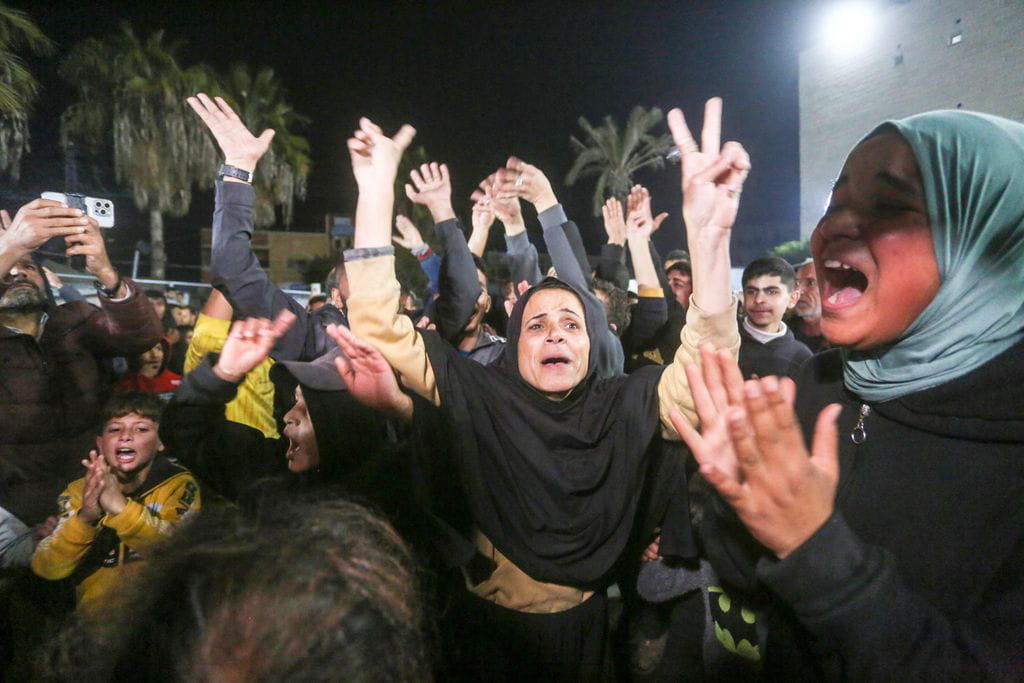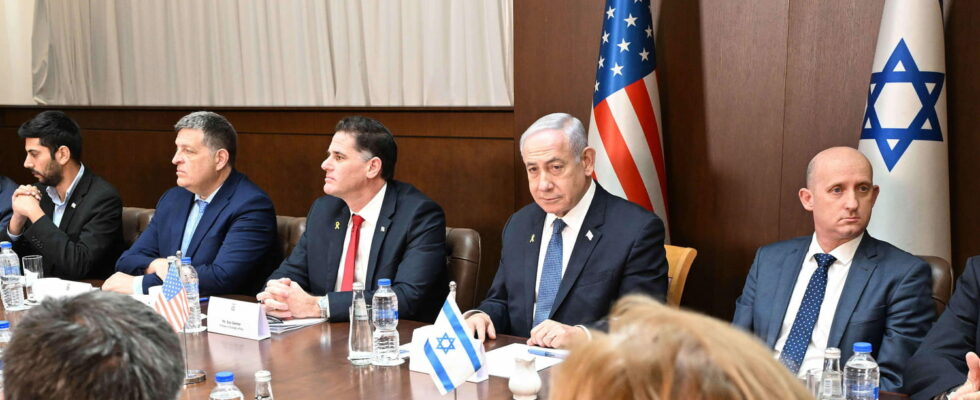The truce agreement between Hamas and Israel must set a clear timetable for bringing the war to an end. For the moment, peace has not yet been achieved.
More than 15 months after the start of the war in Gaza, a truce agreement was approved this Wednesday by Hamas and Israel. A first since the one and only ceasefire in the Palestinian enclave in November 2023. It lasted a week and at the time allowed the exchange of Hamas prisoners for Israeli hostages. This new ceasefire agreement must come into force on [dimanche] January 19,” the Prime Minister of Qatar announced Wednesday evening during a press conference.
In addition to the truce, the agreement also includes a point relating to the exchange of Palestinian prisoners for Israeli hostages, Hamas and its ally Islamic Jihad having “reached an agreement between themselves”, welcomed a source close to the negotiators gathered in Doha, as relayed The Parisian. “We have an agreement on the hostages in the Middle East. They will be released shortly, thank you!” Following the announcement, President-elect Donald Trump reacted on social networks.
But be careful, the protocol provided for in this truce agreement does not mark the definitive end of the fighting. This is what David Khalfa, co-director of the Middle East Observatory, reminded us very well this Thursday on BFMTV. For the latter, everything accelerated due to “the American political configuration, with the arrival of Trump in power and the pressure exerted by him and his emissary on Netanyahu and Hamas”. And what was obtained in haste, in these circumstances, remains fragile. “It is not a peace agreement, it is a suspension of hostilities,” explains this expert.
This Wednesday, the office of Prime Minister Benjamin Netanyahu even claims that Hamas has “withdrew from certain agreements” and is creating a last-minute “crisis” over the release of the hostages. “Hamas is going back on the agreements and creating a crisis that prevents an agreement.” “The government will not meet until the mediators have notified Israel that Hamas has accepted all elements of the agreement,” he added.
On Wednesday evening, Hamas’ main negotiator, Khalil al-Hayya, warned: “We will not forget and we will not forgive” regarding the “suffering” inflicted on the Palestinians. At the same time, a far-right Israeli minister estimated that “the agreement that will be presented to the government is a bad and dangerous agreement for the security of the State of Israel” and warned that his party’s ministers would not did not intend to vote in favor of it even though the agreement must be validated on Thursday by the Israeli government.
The Speaker of the Iranian Parliament, Mohammad-Bagher Ghalibaf, estimated for his part that the agreement “prevented the Zionist regime from achieving its strategic objective”, and formulated a very explicit threat to the Netanyahu government, calling for “action to punish the criminal regime and heal the wounds of the Palestinian nation.” This position could make any hope of a peace agreement obsolete: the militias dependent on Iran could be led to take actions against the Israeli government in the coming weeks, which would annihilate any chance of a lasting peace agreement. . This is the biggest threat to the hope that was born on January 15th.
What this truce agreement contains
During his press conference, the Qatari Prime Minister revealed that the agreement reached consisted of three phases. The first will consist of positioning Israeli troops along the Gaza border, “which will allow an exchange of prisoners, displaced people to find their homes and will also facilitate the transfer of injured people to be able to undergo treatment”, detailed Mohammed bin Abderrahmane Al-Thani.
“A delivery of humanitarian aid throughout the Gaza Strip allowing the entry of essential equipment, particularly for displaced people who lost their homes following the war, as well as the rehabilitation of hospitals and health centers and others” are also on the program for this first phase. Phases two and three remain unclear at this point. They “will be finalized during the implementation of the first phase”, indicated the Prime Minister.

33 hostages released slowly over the next 42 days
Concerning the hostages, 33 should be handed over to the Israeli authorities during a first phase which will also see the release of a thousand Palestinian prisoners currently held in the jails of the Hebrew State. On the side of the hostages, “civilian women […]”, children, the elderly, sick civilians and the wounded”, according to the Qatari Prime Minister, will be released as a priority by Hamas. The first releases are hoped from Sunday or Monday. A release in dribs and drabs is, however, expected with the first phase of the agreement lasting 42 days, the Israeli channel. N12 says that 19 of the 33 hostages will be released during the first 35 days in groups of three or four people. The remaining 14 hostages will be handed over to Israeli authorities within the final week.
In parallel with these exchanges, some 600 humanitarian aid trucks will be authorized to return, without hindrance from the Israelis, to the Gaza Strip to come to the aid of the Palestinian population particularly affected by the fighting which is raging. since October 2023 and the response of the Hebrew state against Hamas after the attack of October 7. Israeli soldiers will therefore be invited, during this truce, to withdraw little by little from the Palestinian enclave. The departure of the Israeli army from certain strategic points, such as the Netzarim corridor (center of the Gaza Strip) and certain places in the Philadelphia corridor (between the Palestinian enclave and Egypt), would be planned. Finally, note that during this first phase, negotiations will take place, with the objective of releasing the last hostages, namely Israeli soldiers for the most part.
Senior officials of the Jewish state have yet to definitively sign the agreement. Questions remain “to be resolved,” said the office of Israeli Prime Minister Benjamin Netanyahu. Unsurprisingly, the international community quickly rejoiced at the news. US President Joe Biden said he was “delighted”. “After fifteen months of unjustifiable ordeal, immense relief for the Gazans, hope for the hostages and their families. This evening, my thoughts are with Ofer and Ohad,” reacted Emmanuel Macron on X, while emphasizing: “The agreement must be respected. The hostages, released. The Gazans, rescued.
10:28 – Senior Hamas official denies delaying finalization of hostage release deal
Faced with Israel’s accusations, Izzat el-Risheq, a senior Hamas official, says he is committed to respecting the conditions announced yesterday by the mediators. The office of Benyamin Netanyahu, the Israeli Prime Minister, had in fact affirmed that Hamas had returned to certain points of the ceasefire agreement.
10:06 – Israel accuses Hamas of creating a last-minute “crisis”
A twist of theater. The office of Benjamin Netanyahu, the Israeli Prime Minister, affirms that the ceasefire agreement was called into question at the last minute by Hamas, which it accuses of creating a “crisis” to delay the finalization of the agreement to release the hostages.
“Hamas is reneging on parts of the agreement reached with the mediators and Israel to try to extort last-minute concessions,” Benjamin Netanyahu said in a statement. “The Israeli cabinet will not meet until the mediators have notified Israel that Hamas has accepted all elements of the agreement,” he added.
09:57 – Many blocking points
Despite the renewed hope of the international community, the truce agreement between Hamas and Israel still contains sticking points. Hamas is in fact demanding a withdrawal of Israeli troops from the Philadelphia corridor, a 14-kilometer buffer zone on the border between Egypt and the Gaza Strip. This buffer zone was originally established by the Israeli army during its second occupation of the Gaza Strip, between 1967 and 2005. The path allowed Israeli soldiers to patrol between the Gaza Strip. The Israeli army regained control in December 2023.
The second disagreement concerns the establishment of another buffer zone, proposed by the Israeli army. This area, inside the Gaza Strip, should run along the eastern and northern borders. More than its existence, it is its surface which is the subject of debate: two kilometers for Israel against a maximum depth of 500 meters for Hamas.
09:28 – “We are not sure that it will end,” warns the former Israeli ambassador to France
Questioned this Thursday morning on France Inter, Elie Barnavi, former Israeli ambassador to France, moderated the joys expressed since yesterday evening. “It’s a long nightmare which is perhaps ending, but there is also anxiety, because we are not sure that it will end. There is also bitterness, because we could have done this a long time ago, and it was not done, it cost human lives, but overall it is relief and joy that dominates,” a-. he declared.
The diplomat is convinced that Benjamin Netanyahu does not intend to sign a peace agreement. “He presents this ceasefire agreement as being provisional. What he is selling to his far-right partners is that the war will start again, as devastating as before between the two phases, he does not there will never be a second phase, but it is a desperate effort to show public opinion that he is still in control of events,” he analyzes. The fact remains that for him, the new American president makes the future uncertain, including for the political future of the Israeli regime. “There would perhaps not have been all this without the Trump effect, which was decisive. We are in another dimension with this strange man, who is determined and who barked at Benyamin Netanyahu.”
